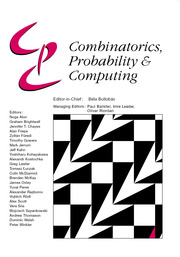No CrossRef data available.
Article contents
Short proof of the hypergraph container theorem
Part of:
Graph theory
Published online by Cambridge University Press: 16 May 2025
Abstract
We present a short and simple proof of the celebrated hypergraph container theorem of Balogh–Morris–Samotij and Saxton–Thomason. On a high level, our argument utilises the idea of iteratively taking vertices of largest degree from an independent set and constructing a hypergraph of lower uniformity which preserves independent sets and inherits edge distribution. The original algorithms for constructing containers also remove in each step vertices of high degree, which are not in the independent set. Our modified algorithm postpones this until the end, which surprisingly results in a significantly simplified analysis.
MSC classification
Primary:
05C30: Enumeration in graph theory
05C65: Hypergraphs
05C69: Dominating sets, independent sets, cliques
Secondary:
05C35: Extremal problems
Information
- Type
- Paper
- Information
- Copyright
- © The Author(s), 2025. Published by Cambridge University Press
References
Balogh, J., Morris, R. and Samotij, W. (2015) Independent sets in hypergraphs. J. Am. Math. Soc. 28(3) 669–709.10.1090/S0894-0347-2014-00816-XCrossRefGoogle Scholar
Balogh, J., Morris, R. and Samotij, W. (2018) The method of hypergraph containers. In Proceedings of the International Congress of Mathematicians 2018, ICM 2018, Rio de Janeiro, Brazil, August 1–9, 2018, Vol. IV Invited lectures, World Scientific, Sociedade Brasileira de Matemática (SBM), Brazil, Hackensack, NJ-Rio de Janeiro, pp. 3059–3092.Google Scholar
Balogh, J. and Samotij, W. (2020) An efficient container lemma. Discrete Anal. 2020 56, Id/No 17.Google Scholar
Bernshteyn, A., Delcourt, M., Towsner, H. and Tserunyan, A. (2019) A short nonalgorithmic proof of the containers theorem for hypergraphs. Proc. Am. Math. Soc. 147(4) 1739–1749.10.1090/proc/14368CrossRefGoogle Scholar
Bucić, M., Fox, J. and Pham, H. T. (2024) Equivalence between Erdős-Hajnal and polynomial Rödl and Nikiforov conjectures, arXiv: 2403.08303.Google Scholar
Campos, M. and Samotij, W. (2024) Towards an optimal hypergraph container lemma, arXiv: 2408.06617.Google Scholar
Morris, R., Samotij, W. and Saxton, D. (2024) An asymmetric container lemma and the structure of graphs with no induced 4-cycle. J. Eur. Math. Soc. 26(5) 1655–1711.10.4171/jems/1442CrossRefGoogle Scholar
Nenadov, R. (2024) Probabilistic hypergraph containers. Israel J. Math. 261(2) 879–897.10.1007/s11856-023-2602-9CrossRefGoogle Scholar
Saxton, D. and Thomason, A. (2015) Hypergraph containers. Invent. Math. 201(3) 925–992.10.1007/s00222-014-0562-8CrossRefGoogle Scholar
Saxton, D. and Thomason, A. (2016) Online containers for hypergraphs, with applications to linear equations. J. Comb. Theory, Ser. B. 121 248–283.10.1016/j.jctb.2016.05.011CrossRefGoogle Scholar
Saxton, D. and Thomason, A. (2016) Simple containers for simple hypergraphs. Comb. Probab. Comput. 25(3) 448–459.CrossRefGoogle Scholar


